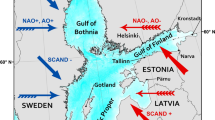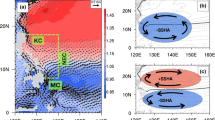Abstract
Empirical orthogonal function (EOF) analysis is performed on the field of the northern hemisphere geopotential height at 200-hPa using a 54-year (1958–2011) record of summer data on an interdecadal time scale. The first dominant mode, which shows smooth semi-hemispheric variation with maximum action centers in the western hemisphere in the mid-latitudes over the eastern Pacific, North America, and the North Atlantic, is related to global warming. The second mode, which has a pronounced tropical-extratropical alternating pattern with active centers located over the eastern hemisphere from Western Europe across East Asia to the western Pacific, has a close relationship with the Arctic Oscillation. Further analysis results indicate that the two dominant modes show good correlation with the Arctic sea ice concentration (SIC), with correlation coefficients between these two modes and the first two EOF modes of the Arctic SIC reaching 0.88 and 0.86, respectively.
Similar content being viewed by others
References
Barnston A G, Livezey R E. 1987. Classification, seasonality and persistence of low-frequency atmospheric circulation patterns. Mon. Wea. Rev., 115: 1 083–1 126.
Bain W C. 1976. The power spectrum of temperature in central England. Quart. J. R. Met. Soc., 102: 464–466.
Bloomfield P. 2000. Fourier Analysis of Time Series. Wiley, New York. 288p.
Branstator G. 2002. Circumglobal teleconnections, the jet stream waveguide, and the North Atlantic Oscillation. J. Climate, 15: 1 893–1 910.
Ding Q H, Wang B. 2005. Circumglobal teleconnection in the Northern Hemisphere summer. J. Climate, 18: 3 483–3 505.
Ding Q H, Wang B. 2007. Intraseasonal teleconnection between the summer Eurasian wave train and the Indian monsoon. J. Climate, 20: 3 751–3 767.
Ding Q H, Wang B, Wallace J M, Branstator G. 2011. Tropicalextratropical teleconnections in boreal summer: observed interannual variability. J. Climate, 24: 1 878–1 896.
Eliasen E A. 1958. A study of the long atmosphere wave on the basis of zonal harmonic analysis. Tellus., 10: 206–215.
Enfield D B, Mestas-Nunez A M, Trimble P J. 2001. The Atlantic Multidecadal Oscillation and its relationship to rainfall and river flows in the continental U.S. Geophys. Res. Lett., 28: 2 077–2 080.
Horel J. 1981. A rotated principal component analysis of the interannual variability of the Northern Hemisphere 500-mb height field. Mon. Wea. Rev., 109: 2 080–2 092.
Huang R H, Li W J. 1987. Influence of the heat source anomaly over the western tropical Pacific on the subtropical high over East Asia. Proc. International conference on the general circulation of East Asia. p.40–51.
IPCC. 2007. In: Solomon S et al. eds. Climate Change 2007: The Physical Science Basis. Contribution of Working Group I to the Fourth Assessment Report of the Intergovernmental Panelon Climate Change. Cambridge University Press, Cambridge.
Kalnay E et al. 1996. The NCEP/NCAR 40-year reanalysis project. Bull. Amer. Meteor. Soc., 77: 437–471.
Kripalani R H, Singh S V. 1993. Large-scale aspects of India-China summer monsoon rainfall. Adv. Atmos. Sci., 10: 72–84.
Kripalani R H, Kulkarni A. 2001. Monsoon rainfall variations and teleconnections over south and East Asia. Int. J. Climatol., 21: 603–616.
Kurihara K, Tsuyuki T. 1987. Development of the barotropic high around Japan and its association with Rossby wavelike propagations over the North Pacific: analysis of August 1984. J. Meteor. Soc. Japan, 65: 237–246.
Lu R Y, Oh J H, Kim B J. 2002. A teleconnection pattern in upper-level meridional wind over the North African and Eurasian continent in summer. Tellus, 54A: 44–55.
Mantua N J, Hare S R, Wallace J M, Francis R C. 1997. A Pacific decadal climate oscillation with impacts on salmon production. Bull. Am. Meteor. Soc., 78: 1 069–1 079.
North G R, Bell T L, Cahalan R F, Moeng F J. 1982. Sampling errors in the estimation of empirical orthogonal functions. Mon. Wea. Rev., 110: 699–706.
Preisendorfer R W. 1988. Principal Component Analysis in Meteorology and Oceanography. Elsevier. 425pp.
Nitta T. 1987. Convective activities in the tropical western Pacific and their impact on the Northern Hemisphere summer circulation. J. Meteor. Soc. Japan, 65: 373–390.
Nitta T, Hu Z Z. 1996. Summer climate variability in China and its association with 500 hPa height and tropical convection. J. Meteor. Soc. Japan, 74: 425–445.
Walsh J E. 1978. A data set on Northern Hemisphere sea ice extent. World Data Center-A for Glaciology (Snow and Ice), Glaciological Data, Report GD-2, Part 1, p.49–51.
Wallace J M, Gutzler D S. 1981. Teleconnections in the geopotential height field during the Northern Hemisphere winter. Mon. Wea. Rev., 109: 784–812.
Wang B, Wu R, Fu X. 2000. Pacific-East Asian teleconnection: how does ENSO affect East Asian climate? J. Climate, 13: 1 517–1 536.
Ueda H, Kawamura R. 2004. Summertime anomalous warming over the midlatitude Western North Pacific and its relationship to the modulation of the Asian monsoon. Int. J. Climatology, 24: 1 109–1 120.
Zhang Y, Wallace J M, Battisti D S. 1997. ENSO-like interdecadal variability: 1900–93. J. Climate, 10: 1 004–1 020.
Zhao J, Cao Y, Shi J. 2010. Spatial variation of the Arctic Oscillation and its long-term change. Tellus A, 62: 661–672.
Author information
Authors and Affiliations
Corresponding author
Additional information
Supported by the National Basic Research Program of China (973 Program) (No. 2010CB951403, 2012CB955604, 2012CB417402, and 2010CB950402) and the National Natural Science Foundation of China (No. 41106018)
Rights and permissions
About this article
Cite this article
Yang, Y., Huang, F. & Wang, H. Dominant modes of geopotential height in the northern hemisphere in summer on interdecadal timescales. Chin. J. Ocean. Limnol. 31, 1120–1128 (2013). https://doi.org/10.1007/s00343-013-2229-5
Received:
Accepted:
Published:
Issue Date:
DOI: https://doi.org/10.1007/s00343-013-2229-5




